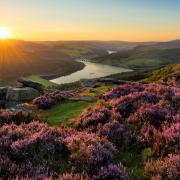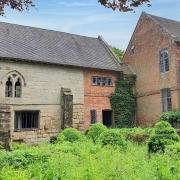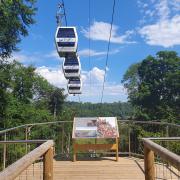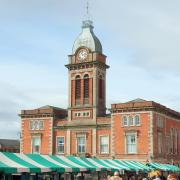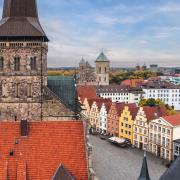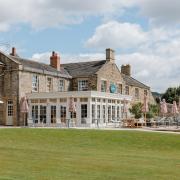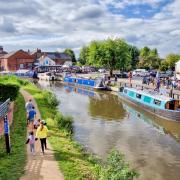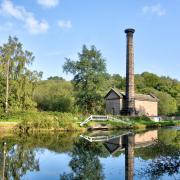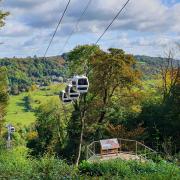The stunning Goyt Valley is not just a place of outstanding natural beauty, it’s a place of intrigue and fascinating local history. Susie Kearley discovers just what makes it such a magical place.
The Goyt Valley is a Peak District gem with glorious reservoirs and an equally fascinating history.
Walking routes around the lakes take in amazing scenery, and you can climb the hills for great views on a clear, sunny day.

It was early spring when we visited. The sun shone down on the water and the deep blue sky and trees were reflected in the lake.
We walked along the water's edge and spotted tiny lizards darting in and out of nooks and crannies in the drystone walls.
Fish splashed in the water, rising to the surface to enjoy the warmth of the sun. Ducks were fighting and squabbling, as they do.
Dragonflies were out in abundance, adding a splash of colour to their natural habitat. The valley is home to an abundance of nature and is wonderfully quiet and serene.

We walked along the shores of both reservoirs. Birds of prey soared overhead, deer appeared among the trees in the wooded areas, then disappeared as soon as they realised they'd been spotted.
The water sparkled, fish jumped, rabbits appeared from the under the shrubs and disappeared again, their white tails bobbing up and down as they retreated. Holes in the ground gave away the secret hideaways of badgers, foxes, rabbits and mice.
There was plenty of unidentified rustling, where little critters of all varieties were hiding and foraging for food. We probably disturbed a few on our amble through this enchanting landscape.
History
The history of the reservoirs is fascinating. During the Industrial Revolution the nearby town of Stockport, just over the Derbyshire border, was growing fast.
Industry was booming and so was population growth. The people of Stockport, Buxton, and nearby villages needed a reservoir to provide water for the burgeoning population and Goyt Valley was a natural source of water.
It had streams running through it and water running down from the hills and as such it seemed logical to create reservoirs in the valley as a means of satisfying the increasing demand from local communities for water.
The wealthy Grimshawe family, a respected merchant family with roots in Manchester, owned the estate and their story would dovetail with the yet-to-be-built reservoirs.

The Grimshawes built Errwood Hall in the 1840s as a magnificent country house, home to five Lords and Ladies, 20 servants and estate staff. Today the Hall is a ruin - little more than arches and foundations remain, surrounded by trees.
They lived there for a few generations, letting out land and properties to tenant farmers, servants, and others who lived and worked on the estate.
However, by 1930 their numbers had dwindled and the only member of the Grimshawe family still living in the valley was Mary Grimshawe.
Mary had been widowed for a second time in 1924 and was living on her own. She passed away in 1930.
The estate manager, one Joseph Oyarzabal, arranged her funeral, which was well attended by estate staff and local people in a service which was conducted by the Bishop of Shrewsbury.
After Mary died, her money was divided according to her will, remembering her staff and local people who'd supported her during her life. The contents of the Hall, which was by now past its heyday, was auctioned off and the estate went up for sale.
It was at this point the Stockport Corporation purchased the house and estate, which included the hamlet of Goyts Bridge. Their intention upon its purchase was to build two reservoirs.

Errwood Hall, perhaps surprisingly, became a Youth Hostel for a few years. Then, in 1934, tenants still living on the estate were told to vacate their homes and farm buildings in order for them to all be demolished, along with Errwood Hall, less than 100 years since its creation.
Thirteen farms and cottages in Goyt Valley were duly destroyed after they left, including a small school. The gardens and walkways around the estate were reclaimed by nature, and the area was eventually flooded to create the two reservoirs.
The first reservoir, Fernilee, was completed in 1938, costing £480,000 and holding 4,940 million litres of water.
The second, Errwood Reservoir, was delayed by 30 years due to financial problems and manpower shortages caused by the Second World War. It was eventually completed in 1967, costing £1.5million and holding 4,215 million litres of water.
The story of the demise of the Derwent and Ashopton villages in the Derwent Valley to make way for what is now Ladybower Reservoir arguably receives more attention than the areas lost under the water in Goyt Valley but that’s not to say the latter doesn’t hold secrets below its depths.
Under Fernilee Reservoir, for example, are the remains of the Chilworth Gunpowder Mill, which stopped operating in 1920.
The mill made chemical explosives from the 16th century, through to the First World War. In 1937, water enveloped the remains of the old Mill and took the ruins into its dark abyss.

The end of an era
While the absence of a disused mill wasn't any great loss to local people, the creation of the reservoirs came at a greater cost to people who still lived in the Goyt Valley.
The requirement to abandon their homes in 1934 so the buildings could be dismantled and the area flooded meant they all had to start new lives elsewhere, whether they wanted to do or not.
Before the flooding, Goyts Bridge was a very picturesque hamlet, with a stream running through the centre. It was a popular place for Victorians to travel through with their horse-drawn carts.
Errwood Hall stood overlooking the valley for almost a century. Today, only ruins remain and there's a small hill-top cemetery, where the remains of the Grimshawe family and their favourite servants are buried.
The path to the graves originally went through an archway, but today the arch has gone and only the steps remain.
The Grimshawe's graves include Mary, the last resident of Errwood Hall before its demolition; Samuel Grimshawe, who died in 1883; his wife Jessie; and their son Arthur, who died at the age of just 15 months of intestinal inflammation.

For visitors today
Visitors to Goyt Valley today can enjoy the tranquil location and scenic views from the many walks around the old estate.
It's a quiet place to get away from the busyness of modern life and reflect on the wonder of nature. Even when the weather's cold, it's a fantastic place for a brisk walk on a sunny day.
The 200-mile Peak District Boundary Walk has helped popularise the area still further, taking walkers along both reservoirs.
There are 28 different walks on a dedicated Goyt Valley website, found at: goyt-valley.org.uk/project/walk-maps.






